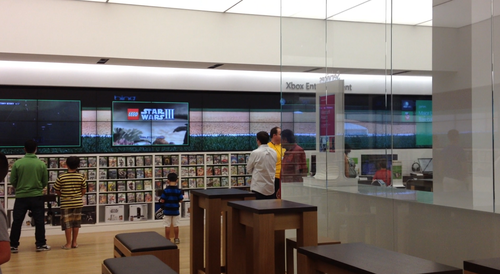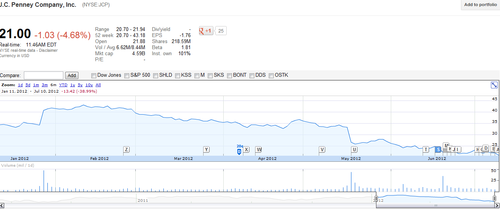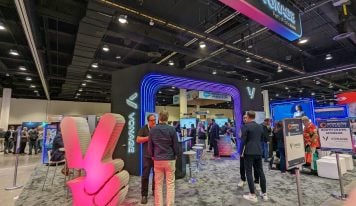Microsoft Store in Danbury, CT
Global Apple stores are brimming with traffic with municipalities tripping over each other to get Apple to open stores in their areas. At the same time, the Microsoft Store in the Danbury Fair Mall in Connecticut had a fraction of the foot traffic of the nearby Apple Store this past weekend according to fellow TMC blogger Tom Keating. The good news for Steve Ballmer is Tom likes the layout of the Microsoft store better. These are his exact thoughts:
My next thought was, “It’s better.” The Apple Store has this clean simplistic design with lots of white and clear plastic, but it lacks the fun factor and has this almost cold, hospital, sterile-like atmosphere. I found the Microsoft Store to be warm, fun, and futuristic. The store has huge flat screen displays lining the walls that are perfectly recessed into the wall so they don’t stick out even one inch. In front of some of these displays are Xboxes and Kinects to allow visitors to play video games. While I saw some kids jumping and laughing playing a Kinect game I couldn’t help but wonder if they were loud in the Apple Store. I imagined the Apple Store employees and indeed the Apple customers themselves would turn to the laughing kids and shush them like a librarian would do in a library and thinking to themselves, “Hush children. This is hollowed Apple ground. Would you be rowdy in a church?” While I may exaggerate the serious “feel” of the Apple Store compared to the Microsoft Store, there definitely is a more of a business-type atmosphere in the Apple Store while the Microsoft Store was more fun.
See the Microsoft Store 360 degree view
Tom thinks that the introduction of Microsoft’s tablets will turn the tide and fill the Microsoft stores. I am sure Redmond hopes so. But if retail is the future of consumer electronics and computing then doesn’t Google need stores – and fast? And what about Samsung and HTC?
The point is these stores are more than retail for Apple, they are marketing. You could make the same argument about the Samsung Experience store in Manhattan but in this case you would be 100% accurate as can’t buy anything – it is a product showcase.
But while we are getting giddy about how consumer electronics companies need retail to be successful, we should stop for a moment and realize that Best Buy is about to lay off 2,400 workers consisting of 600 Geek Squad tech support specialists and 1,800 store employees. We all know the problem but may not be familiar with the term showrooming which as the name implies means you shop in a brick and mortar location and then buy online.
So I got to thinking about author Robert Fulghum who wrote Everything I Really Needed to Know I Learned in Kindergarten. I remember when I was in my mid-single digits Sesame Street taught me a song called “One of these things is not like the other.” In this case Apple stands out.
Obviously we know about the company’s superior products, the Steve Jobs legacy of attention to detail combined with an innate understanding of consumer desires.
But it is more than that. You see, Apple products are sold without discounting for the most part so if you visit in the store, you have little to gain by shopping online – except perhaps sales tax savings in some cases. The situation is far different in most of the rest of consumer electronics except for other premium brands like Bose and Bang and Olufsen.
If the PC market and the rest of the industry thinks they can successfully change to such a pricing model overnight they will be sorely disappointed. In the publishing world one of the biggest challenges is to get an audience to pay for something they once got for free. In retail the corollary is going from discounting to charging full retail price.
The most recent attempt at this strategy shift took place at J.C. Penny where less than 1% of the merchandise sold at full price. CEO Ron Johnson who is the former Apple retail head tried to abruptly change the way the store did business and got walloped by Wall Street when earnings were missed as a result of rapidly replacing discounted prices with more “reasonable” everyday pricing. The strategy by the way has already been tweaked with the addition of discounting.
6 Month J.C. Penney stock performance
To summarize:
- It seems the CE market is waking up to the fact they need to rely more on retail.
- Consumer electronics retail is having trouble as evidenced by Best Buy.
- One way to increase retail sales and more importantly add value to your brand is to stop discounting.
- But Best Buy sells Apple products at retail and is struggling.
- Best Buy for its part has finally realized there is a larger problem and is testing new stores which look like those from Cupertino.
- JC Penney is trying to evolve its sales strategy with non-discounted pricing and the transformation takes time if it is even doable.
- The circular nightmare for Apple competitors? If you compete with Apple and don’t have a profitable retail strategy then you can’t compete with Apple.
All of this is taking place at a time when more people are so comfortable with products from Cupertino that they are OK with switching to Mac products when their PCs need replacing. And the younger generation doesn’t have the same connection to Microsoft which most of my readers do.
This really leaves the consumer electronics, gadgets and PC market in a major conundrum. Google, Microsoft, RIM, HP and others really need solutions which are better than those from Apple or at least good enough that consumers won’t mind paying retail prices to purchase them.





